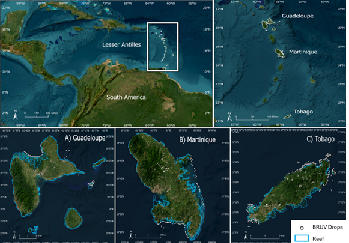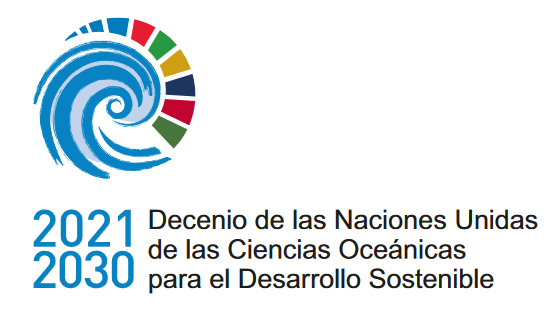Abundancia relativa y uso de elasmobranquios en la pesca artesanal de las Antillas Menores
DOI:
https://doi.org/10.47193/mafis.3812025010103Palabras clave:
Guadalupe, Martinica, Tobago, Caribe, BRUVS, encuestasResumen
Las poblaciones de tiburones y rayas continúan disminuyendo en muchas regiones del mundo. La contribución de la pesca artesanal a esta disminución sigue siendo poco conocida en muchos lugares. Se empleó un marco de evaluación rápida que utiliza muestreo independiente de las pesquerías y entrevistas a pescadores para estudiar la presencia y el uso de elasmobranquios en las pesquerías artesanales costeras de Guadalupe, Martinica y Tobago. Se realizaron entrevistas personalmente (n = 405) entre junio de 2015 y junio de 2017, y desplegamos estaciones remotas de video submarino con cebo (BRUVS) (n = 50 lanzamientos de video/arrecife) en nueve arrecifes de las islas. El destino de las capturas de elasmobranquios de los pescadores artesanales varió según la Isla. Martinica informó la mayor proporción de pescadores que conservan sus capturas para el sustento (es decir, pesca de subsistencia) de todas las islas. En Guadalupe, los pescadores principalmente vendieron sus capturas, y los pescadores de Tobago se dedicaron tanto a la pesca de subsistencia como a la venta. También encontramos que los pescadores retuvieron casi todos los ejemplares capturados y reportaron capturas reducidas de elasmobranquios en comparación a cuando comenzaron a pescar. BRUVS reveló una presencia de elasmobranquios relativamente baja y un índice de diversidad de Shannon bajo en comparación con las naciones del Caribe con menos presión pesquera sobre los elasmobranquios. El presente estudio destaca la necesidad de mejorar los datos y el seguimiento de las capturas artesanales.
Descargas
Referencias
Agard R, Gobin J. 2000. The Lesser Antilles, Trinidad and Tobago. In: Sheppard CRC, editor. Seas at the millennium: an environmental evaluation: 1. Regional chapters: Europe, The Americas and West Africa. Amsterdam: Pergamon. p. 627-641.
Aldrich R, Connell J. 1992 From France’s overseas frontier: départements et territoires d’outre-mer. Cambridge University Press. 357 p.
Ali L. 2019. A Biological and social examination of commonly exploited shark species in Trinidad and Tobago [MSc thesis]. University of the West Indies.
Ali L, Grey E, Singh D, Mohammed A, Tripathi V, Gobin J, Ramnarine I. 2020. An evaluation of the public’s Knowledge, Attitudes and Practices (KAP) in Trinidad and Tobago regarding sharks and shark consumption. PLoS ONE. 15 (6): e0234499.
Applegate S, Soltelo-Macías F, Espinosa-Arrubarrena L. 1993. An overview of Mexican shark fisheries, with suggestions for shark conservation in Mexico. Conservation biology of sharks. NOAA Tech Rep NMFS. 115: 31-37.
Belhabib D, Cheung W, Kroodsma D, Lam V, Underwood P, Virdin J. 2020. Catching industrial fishing incursions into inshore waters of Africa from space. Fish Fish. 21 (2): 379-392.
Bell J, Watson R, Ye Y. 2017. Global fishing capacity and fishing effort from 1950 to 2012. Fish Fish. 18 (3): 489-505.
Bond M, Babcock E, Pikitch E, Abercrombie D, Lamb N, Chapman D. 2012. Reef sharks exhibit site-fidelity and higher relative abundance in marine reserves on the Mesoamerican Barrier Reef. PLoS ONE. 7 (3): e32983.
Booth H, Powell G, Yulianto I, Simeon B, Adrianto L, Milner-Gulland EJ. 2022. Exploring cost-effective management measures for reducing risks to threatened sharks in a problematic longline fishery. Ocean Coast Manage. 225: 106197. DOI: https://doi.org/10.1016/j.ocecoaman.2022.106197
Brooks E, Sloman K, Sims D, Danylchuk A. 2011. Validating the use of baited remote underwater video surveys for assessing the diversity, distribution and abundance of sharks in the Bahamas. Endang Species Res. 13 (3): 231-243.
Bunce M, Rodwell L, Gibb R, Mee L. 2008. Shifting baselines in fishers’ perceptions of island reef fishery degradation. Ocean Coast Manage. 51 (4): 285-302.
Butcher P, Peddemors V, Mandelman J, McGrath S, Cullis B. 2015. At-vessel mortality and blood biochemical status of elasmobranchs caught in an Australian commercial longline fishery. Global Ecol Conserv. 3: 878-889.
Cáceres C, Kiszka J, Luna‐Acosta A, Herrera H, Zarza E, Heithaus M. 2022. Predatory fish exploitation and relative abundance in a data‐poor region from the Caribbean coast of Colombia, inferred from artisanal fishery interview surveys and baited remote underwater video systems. Aquat Conserv Mar Freshwat Ecosyst. 32 (9): 1401-1415.
Carder N, Crock J. 2012. A pre-Columbian fisheries baseline from the Caribbean. J Archaeol Sci. 39 (10): 3115-3124.
Chakalall B. 1995. Fisheries management in the Lesser Antilles. Proceedings of the 42nd Gulf and Caribbean Fisheries Institute. 42. p. 294-330.
Clementi G, Babcock E, Valentin-Albanese J, Bond M, Flowers K, Heithaus M, Whitman E, Bergmann M, Guttridge T, et al. 2021. Anthropogenic pressures on reef-associated sharks in jurisdictions with and without directed shark fishing. Mar Ecol Progr Ser. 661: 175-186.
Cook ND, Clementi GM, Flowers KI, Fanovich L, Cable J, Perkins SE, Wothke A, Mohammed RS, Chapman DD. 2024. Elasmobranch diversity around the southern Caribbean Island of Tobago: opportunities for conservation in a regional trade hub. J Mar Biol Assoc UK. 104: e8. DOI: https://doi.org/10.1017/S0025315423000917
Cooley S, Kite-Powell H, Doney S. 2009. Ocean acidification’s potential to alter global marine ecosystem services. Oceanography. 22 (4): 172-181.
Davidson L, Krawchuk M, Dulvy N. 2016. Why have global shark and ray landings declined: improved management or overfishing? Fish Fish. 17 (2): 438-458.
Deme E, Amalatchy Y, Jumpe R, Bocoum W, Dème M, Failler P, Soumah M, Sidibeh M, Diédhiou I, March A, Touron-Gardic G. 2022. Migration of artisanal fishers targeting small pelagics in West Africa: current trends and development. Mar Fish Sci. 36 (1): 31-52. DOI: https://doi.org/10.47193/mafis.3612023010104
Dillon E, McCauley D, Morales-Saldaña J, Leonard N, Zhao J, O’Dea A. 2021. Fossil dermal denticles reveal the preexploitation baseline of a Caribbean coral reef shark community. Proc Natl Acad Sci. 118 (29): e2017735118.
Dulvy N, Fowler S, Musick J, Cavanagh R, Kyne P, Harrison L, Carlson JK, Davidson LNK, Fordham SV, Francis MP, et al. 2014. Extinction risk and conservation of the world’s sharks and rays. eLife. 3: e00590. DOI: https://doi.org/10.7554/eLife.00590
Dulvy N, Pacoureau N, Rigby C, Pollom R, Jabado R, Ebert D, Finucci B, Pollock C, Cheok J, Derrick D, Herman K. 2021. Overfishing drives over one-third of all sharks and rays toward a global extinction crisis. Curr Biol. 31 (21): 4773-4787.
Dulvy N, Simpfendorfer C, Davidson L, Fordham S, Bräutigam A, Sant G, Welch D. 2017. Challenges and priorities in shark and ray conservation. Curr Biol. 27 (11): 565-572.
[FAO] Food and Agriculture Organization of the United Nations. 2004. Western Central Atlantic Fishery Commission. Report of and papers presented at the second meeting of the WECAFC ad hoc working group on the development of sustainable moored fish aggregating device fishing in the Lesser Antilles. Bouillante, Guadeloupe. 5-10 July 2004. FAO Fish Rep. 797. 274 p.
[FAO] Food and Agriculture Organization of the United Nations. 2016. Identification guide to common sharks and rays of the Caribbean, by Ramón Bonfil. FishFinder Programme. Rome: FAO.
[FAO] Food and Agriculture Organization of the United Nations. 2022. The State of world fisheries and aquaculture. Rome: FAO.
Ferretti F, Worm B, Britten G, Heithaus M, Lotze H. 2010. Patterns and ecosystem consequences of shark declines in the ocean. Ecol Lett. 13 (8): 1055-1071.
Frotté L, Harper S, Veitch L, Booth S, Zeller D. 2009. Reconstruction of marine fisheries catches for Guadeloupe from 1950-2007. In: Zeller D, Harper S, editors. Fisheries catch reconstructions: islands, part I. Fish Cent Res Rep. 17 (5): 13-19.
Gallagher A, Orbesen E, Hammerschlag N, Serafy J. 2014. Vulnerability of oceanic sharks as pelagic longline bycatch. Global Ecol Conserv. 1: 50-59.
Gilman E, Chaloupka M, Merrifield M, Malsol N, Cook C. 2016. Standardized catch and survival rates, and effect of a ban on shark retention, Palau pelagic longline fishery. Aquat Conserv Mar Freshwat Ecosyst. 26 (6): 1031-1062.
Goetze JS, Heithaus MR, MacNeil MA, Harvey E, Simpfendorfer CA, Heupel MR, Meekan M, Wilson S, Bond ME, Speed CW, et al. 2024. Directed conservation of the world’s reef sharks and rays. Nat Ecol Evol. 8 (6): 1118-1128. DOI: https://doi.org/10.1038/s41559-024-02386-9
Gobert B. 2000. Comparative assessment of multispecies reef fish resources in the Lesser Antilles. Fish Res. 44 (3): 247-260.
Hawkins J, Roberts C. 2004. Effects of artisanal fishing on Caribbean coral reefs. Conserv Biol. 18 (1): 215-226.
Henry C, Martin L. 1992. Preliminary stock assessment for the carite fishery of Trinidad. Technical report of the Project for the Establishment of Data Collection Systems and Assessment of the Fisheries Resources. FAO/UNDP: TRI/91/001. Port of Spain: Ministry of Agriculture, Land and Marine Resources. 32 p.
Horta S, Defeo O. 2012. The spatial dynamics of the whitemouth croaker artisanal fishery in Uruguay and interdependencies with the industrial fleet. Fish Res. 125: 121-128.
Hutchinson SD, Seepersad G, Singh R, Rankine L. 2012. Study on the socio-economic importance of by-catch in the demersal trawl fishery for shrimp in Trinidad and Tobago. [accessed 2024 Mar]. https://www.fao.org/fishery/docs/DOCUMENT/rebyc/trinidadtobago/UWI_MALMR_ByCatch_Report_Final_ver3.pdf.
Lack M, Sant G, Burgener M, Okes N. 2014. Development of a rapid management-risk assessment method for fish species through its application to sharks: framework and results. Department of Environment, Food and Rural Affairs. Defra Contract MBO123. [accessed 2024 Mar]. https://www.cms.int/sharks/sites/default/files/document/Development%20of%20a%20Rapid%20Management%20Risk%20Assessment%20Method%20-%20Final%20Report.pdf.
MacNeil M, Chapman D, Heupel M, Simpfendorfer C, Heithaus M, Meekan M, Harvey E, Goetze J, Kiszka J, Bond M, et al. 2020. Global status and conservation potential of reef sharks. Nature. 583 (7818): 801-806.
Morgan A, Carlson J. 2010. Capture time, size and hooking mortality of bottom longline-caught sharks. Fish Res. 101 (1-2): 32-37.
Mumby P, Steneck R, Edwards A, Ferrari R, Coleman R, Harborne A, Gibson J. 2012. Fishing down a Caribbean food web relaxes trophic cascades. Mar Ecol Progr Ser. 445: 13-24.
Myers R, Worm B. 2003. Rapid worldwide depletion of predatory fish communities. Nature. 423 (6937): 280.
Myers R, Worm B. 2005. Extinction, survival or recovery of large predatory fishes. Phil Trans R Soc B: Biol Sci. 360 (1453): 13-20.
Nakamura J, Diz D, Morger E. 2022. International legal requirements for environmental and socio‐cultural assessments for large‐scale industrial fisheries. Rev Eur Comp Int Environ Law. 31 (3): 336-348.
Niedermüller S, Ainsworth G, de Juan S, García R, Ospina-Alvarez A, Pita P, Villasante S. 2021. The shark and ray meat network: a deep dive into a global affair. Rome: WWF MMI. [accessed 2024 Mar]. https://sharks.panda.org/images/downloads/392/WWF_MMI_Global_shark__ray_meat_trade_report_2021_lowres.pdf.
Pacoureau N, Rigby C, Kyne P, Sherley R, Winker H, Carlson J, Fordham S, Barreto R, Fernando D, Francis M, Jabado R. 2021. Half a century of global decline in oceanic sharks and rays. Nature. 589 (7843): 567-571.
Pinheiro H, Goodbody-Gringley G, Jessup M, Shepherd B, Chequer A, Rocha L. 2016. Upper and lower mesophotic coral reef fish communities evaluated by underwater visual censuses in two Caribbean locations. Coral Reefs. 35: 139-151.
R Core Team. 2016. R: A language and environment for statistical computing. R Foundation for Statistical Computing. Viena. https://www.r-project.org.
Ricklefs R, Lovette I. 1999. The roles of island area per se and habitat diversity in the species-area relationships of four Lesser Antillean faunal groups. J Anim Ecol. 68 (6): 1142-1160.
Ritter J. 2013. A characterization of the shark fisheries in Campeche, Mexico [MSc dissertation]. Durham: Nicholas School of the Environment, Duke University. 60 p.
Sherman CS, Simpfendorfer CA, Pacoureau N, Matsushiba JH, Yan HF, Walls RHL, Rigby CL, VanderWright WJ, Jabado RW, Pollom RA, et al. 2023. Half a century of rising extinction risk of coral reef sharks and rays. Nat Commun. 14 (1): 15.
Shing CCA. 1993. The status of shark resources in Trinidad and Tobago. Trinidad and Tobago: Ministry of Agriculture Land and Marine Resources. Fisheries Division Fisheries Internal Report No. 218.
Shing CCA. 2006. Shark fisheries of Trinidad and Tobago: a national plan of action. Proceedings of the 57th Gulf and Caribbean Fisheries Institute. 47. p. 206-213.
Simpfendorfer C, Heithaus M, Heupel M, MacNeil M, Meekan M, Harvey E, Sherman C, Currey-Randall L, Goetze J, Kiszka J, et al. 2023. Widespread diversity deficits of coral reef sharks and rays. Science. 380 (6650): 1155-1160.
Smart J, White W, Baje L, Chin A, D’Alberto B, Grant M, Mukherji S, Simpfendorfer C. 2020. Can multi‐species shark longline fisheries be managed sustainably using size limits? Theoretically, yes. Realistically, no. J Appl Ecol. 57 (9): 1847-1860.
Smith A, Rogers C, Bouchon C. 1997. Status of western Atlantic coral reefs in the Lesser Antilles. In: Proc 8th Int Coral Reef Symp. 1: 351-356.
Stallings C. 2009. Fishery-independent data reveal negative effect of human population density on Caribbean predatory fish communities. PLoS ONE. 4(5): e5333.
Talwar B, Anderson B, Avalos‐Castillo C, del Pilar Blanco‐Parra M, Briones A, Cardeñosa D, Carlson J, Charvet P, Cotton C, Crysler Z, Derrick D. 2022. Extinction risk, reconstructed catches and management of chondrichthyan fishes in the Western Central Atlantic Ocean. Fish Fish. 23 (5): 1150-1179.
Vermeij M, Latijnhouwers K, Dilrosun F, Chamberland V, Dubé C, Van Buurt G, Debrot A. 2019. Historical changes (1905-present) in catch size and composition reflect altering fisheries practices on a small Caribbean Island. PLoS ONE. 14 (6): e0217589.
Ward-Paige C, Mora C, Lotze H, Pattengill-Semmens C, McClenachan L, Arias-Castro E, Myers R. 2010. Large-scale absence of sharks on reefs in the greater-Caribbean: a footprint of human pressures. PLoS ONE. 5 (8): e11968.
Ward-Paige C, Pattengill-Semmens C, Myers R, Lotze H. 2011. Spatial and temporal trends in yellow stingray abundance: evidence from diver surveys. Environ Biol Fish. 90 (3): 263-276.
Whitman ER. 2018. Factors affecting green turtle foraging ecology across multiple spatial scales [PhD thesis]. Miami: Florida International University. 198 p. https://digitalcommons.fiu.edu/etd/3870.
Wing S, Wing E. 2001. Prehistoric fisheries in the Caribbean. Coral Reefs. 20 (1): 1-8.
Worm B, Orofino S, Burns E, D’Costa N, Manir Feitosa L, Palomares M, Schiller L, Bradley D. 2024. Global shark fishing mortality still rising despite widespread regulatory change. Science. 383 (6679): 225-230.
Worm B, Sandow M, Oschlies A, Lotze H, Myers R. 2005. Global patterns of predator diversity in the open oceans. Science. 309 (5739): 1365-1369.
Zeller D, Harper S, editors. 2009. Fisheries catch reconstructions: islands, part I. Fish Cent Res Rep. 17 (5). 108 p. https://fisheries.sites.olt.ubc.ca/files/2016/08/17-5.pdf.

Descargas
Publicado
Número
Sección
Licencia
Derechos de autor 2025 Camila Cáceres, Lauren Ali, Oceane Beaufort, Welldon Mapp, Aljoscha Wothke, Bethan Roberts, Philip Matich, Michael Heithaus

Esta obra está bajo una licencia internacional Creative Commons Atribución-NoComercial-CompartirIgual 4.0.
Los autores de los artículos publicados en Marine and Fishery Sciences conservan los derechos de autor de sus artículos, a excepción de las imágenes de terceros y otros materiales añadidos por Marine and Fishery Sciences, que están sujetos a los derechos de autor de sus respectivos propietarios. Por lo tanto, los autores son libres de difundir y volver a publicar sus artículos, sujeto a los requisitos de los propietarios de derechos de autor de terceros y sujeto a que la publicación original sea completamente citada. Los visitantes también pueden descargar y reenviar artículos sujetos a los requisitos de citas. La capacidad de copiar, descargar, reenviar o distribuir cualquier material siempre está sujeta a los avisos de derechos de autor que se muestran. Los avisos de copyright deben mostrarse de manera prominente y no pueden borrarse, eliminarse u ocultarse, total o parcialmente. El autoalmacenamiento en servidores y repositorios de preimpresión está permitido para todas las versiones.
Esta revista ofrece a los autores una política de acceso abierto. Los usuarios pueden leer, descargar, copiar, distribuir, imprimir, buscar o vincular los textos completos de los artículos, o usarlos para cualquier otro propósito legal dentro de la licencia Creative Commons 4.0 (BY-NC-SA), sin solicitar permiso previo del editor o del autor. Esto está de acuerdo con la definición BOAI de acceso abierto.

























